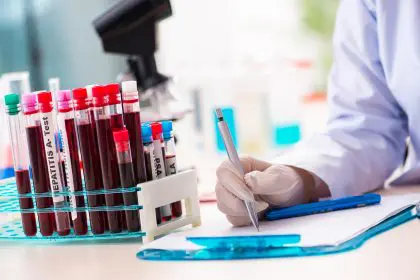Discovering blood in your vomit creates immediate alarm and concern. This symptom, medically termed hematemesis, signals something significant happening in your digestive tract that requires attention. Understanding the potential causes, severity indicators, and appropriate responses can make a critical difference in outcomes.
Recognizing hematemesis
Hematemesis specifically refers to blood that is vomited from the digestive tract—typically the esophagus, stomach, or upper small intestine. This blood may appear bright red if bleeding is severe and recent, but more commonly looks like coffee grounds—dark and granular—because stomach acid breaks down the blood, changing its appearance.
Vomited blood often mixes with food particles and usually follows nausea, abdominal pain, or retching. The volume can range from small streaks to large amounts that can rapidly lead to dangerous blood loss if the bleeding source is significant.
This differs from blood that is coughed up from the respiratory system, which typically appears bright red, may contain air bubbles, and emerges after coughing rather than vomiting.
Common causes of vomited blood
Various conditions can cause hematemesis, ranging from common concerns to life-threatening emergencies:
Peptic ulcers—open sores in the stomach or duodenum (first part of the small intestine)—represent one of the most common causes. These ulcers can erode into blood vessels, causing bleeding that ranges from slow seepage to severe hemorrhage. Typical accompanying symptoms include burning abdominal pain, particularly between meals or at night, feeling full quickly, and bloating.
Gastritis, inflammation of the stomach lining, frequently causes hematemesis, particularly in its erosive form. This condition typically results from irritants like alcohol, nonsteroidal anti-inflammatory drugs (NSAIDs), or certain medications damaging the protective stomach lining. Symptoms often include upper abdominal pain, nausea, and discomfort after eating.
Esophageal conditions commonly lead to hematemesis. Esophageal varices—enlarged veins in the esophagus typically caused by liver cirrhosis—can rupture and cause severe bleeding. Mallory-Weiss tears—small tears in the esophageal lining often caused by forceful vomiting or coughing—typically cause bright red bleeding. Esophagitis, inflammation of the esophagus often due to acid reflux, can erode the lining enough to cause bleeding.
Gastrointestinal malignancies must be considered, particularly in older adults or those with risk factors. Stomach cancer, esophageal cancer, and occasionally small intestinal tumors can all cause bleeding. Additional concerning symptoms include unexplained weight loss, progressive difficulty swallowing, persistent abdominal pain, or early satiety.
Certain medications increase bleeding risk throughout the digestive tract. Anticoagulants (“blood thinners”), antiplatelet medications, NSAIDs, and excessive alcohol consumption all can contribute to or cause gastrointestinal bleeding, particularly when combined with other risk factors like ulcers or varices.
When to seek immediate medical attention
Certain characteristics indicate potentially life-threatening situations requiring emergency care:
The volume and appearance of blood provide critical information. Vomiting more than a few teaspoons of blood always warrants immediate medical attention. Bright red blood suggests active, recent bleeding that may be more serious than older “coffee-ground” appearance.
Associated symptoms often indicate severity. Accompanying lightheadedness (especially when standing), confusion, rapid heart rate, pale or clammy skin, or passing black, tarry stools (indicating digested blood moving through the intestines) suggest significant blood loss requiring emergency care.
Medical background influences risk assessment. Individuals with known liver disease (particularly cirrhosis), prior digestive tract bleeding, or who take blood-thinning medications should consider any amount of hematemesis potentially serious.
The rate of bleeding progression matters significantly. Bleeding that appears to be increasing in volume or frequency requires immediate evaluation, as does recurrent vomiting with blood when previous episodes contained none.
First aid and immediate steps
While awaiting medical attention, certain measures can help manage the situation:
Position yourself appropriately to prevent complications. Sit upright or lie with your head turned to the side to prevent aspiration (inhaling vomited material into the lungs). If feeling lightheaded, lying with legs slightly elevated may help maintain blood flow to vital organs while keeping the head turned.
Document important details about the bleeding. Note the approximate amount, color, and consistency of the blood, along with any accompanying symptoms like abdominal pain, preceding nausea, or recent black stools.
Avoid actions that might worsen bleeding. Don’t take aspirin, NSAIDs, or blood-thinning medications. Avoid hot beverages, alcohol, or spicy foods that might irritate the digestive tract. Don’t eat or drink anything if bleeding is severe, as this complicates potential surgical management.
Prepare relevant information for medical providers, including medication list, medical history (particularly regarding liver, ulcer, or previous bleeding issues), and recent symptoms leading up to the bleeding.
Diagnostic and treatment approaches
Healthcare providers follow systematic approaches to identify and address the bleeding source:
Upper endoscopy typically serves as the primary diagnostic tool. This procedure involves passing a flexible scope with a camera through the mouth into the esophagus, stomach, and upper small intestine. Endoscopy allows direct visualization of bleeding sources and enables immediate treatment of certain conditions.
Laboratory assessment helps determine blood loss severity and potential causes. Complete blood counts help determine the need for transfusion, while liver function tests and other studies may identify underlying causes.
Treatment approaches vary based on findings and severity:
Endoscopic interventions often provide immediate treatment during the diagnostic procedure. Techniques include injecting medications directly into bleeding sites, applying clips to bleeding vessels, cauterizing bleeding areas, or using bands to tie off bleeding varices.
Medication therapy addresses underlying causes. This might include acid-reducing medications for ulcers or gastritis, antibiotics for H. pylori infection, or medications to reduce portal pressure for patients with varices.
Blood component therapy becomes necessary in severe cases to replace lost blood and restore normal circulation. This may include red blood cell transfusions, plasma, or platelet transfusions depending on the specific situation.
Surgical intervention becomes necessary when bleeding cannot be controlled through other methods or when specific conditions require surgical repair.
By understanding the significance of blood in vomit and taking appropriate action when it occurs, you can ensure proper care for this potentially serious symptom and improve outcomes for the underlying conditions causing it.







